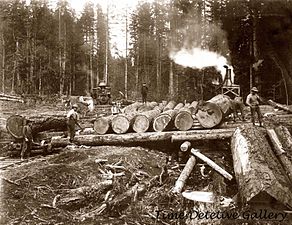
A geared steam locomotive is a type of steam locomotive which uses gearing, usually reduction gearing, in the drivetrain, as opposed to the common directly driven design.

The Shay locomotive is a geared steam locomotive that originated and was primarily used in North America. The locomotives were built to the patents of Ephraim Shay, who has been credited with the popularization of the concept of a geared steam locomotive. Although the design of Ephraim Shay's early locomotives differed from later ones, there is a clear line of development that joins all Shays. Shay locomotives were especially suited to logging, mining and industrial operations and could operate successfully on steep or poor quality track.
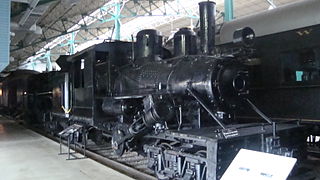
A Climax locomotive is a type of geared steam locomotive built by the Climax Manufacturing Company, of Corry, Pennsylvania. These had two steam cylinders attached to a transmission located under the center of the boiler, which sent power to driveshafts running to the front and rear trucks. Some 1000-1100 were built in three classes - A, B, and C - between 1888 and 1928.

The Roaring Camp & Big Trees Narrow Gauge Railroad is a 3 ft narrow-gauge tourist railroad in California that starts from the Roaring Camp depot in Felton, California and runs up steep grades through redwood forests to the top of nearby Bear Mountain, a distance of 3.25 miles.

Cass Scenic Railroad State Park is a state park and heritage railroad located in Cass, Pocahontas County, West Virginia.

The Yosemite Mountain Sugar Pine Railroad (YMSPRR) is a historic 3 ft narrow gauge railroad with two operating steam locomotives located near Fish Camp, California, in the Sierra National Forest near the southern entrance to Yosemite National Park. Rudy Stauffer organized the YMSPRR in 1961, utilizing historic railroad track, rolling stock and locomotives to construct a tourist line along the historic route of the Madera Sugar Pine Lumber Company.

The Sumpter Valley Railway, or Sumpter Valley Railroad, is a 3 ft narrow gauge heritage railroad located in Baker County, in the U.S. state of Oregon. Built on a right-of-way used by the original railway of the same name, it carries excursion trains on a roughly 5-mile (8.0 km) route between McEwen and Sumpter. The railroad has two steam locomotives and several other pieces of rolling stock. Passenger excursion trains operate on weekends and holidays from Memorial Day through the end of September.

The Yacolt Burn is the collective name for dozens of fires in Washington state and Oregon occurring between September 8 and September 12, 1902, causing 38 deaths in the Lewis River area, at least nine deaths by fire in Wind River and 18 deaths in the Columbia River Gorge.

The Oregon, Pacific and Eastern Railway is an Oregon-based short line railroad that began near Eugene as the Oregon and Southeastern Railroad (O&SE) in 1904. O&SE's line ran 18 miles (29 km) along the Row River between the towns of Cottage Grove and Disston. The Oregon, Pacific & Eastern Railway Company incorporated in 1912, purchased the physical assets of the O&SE two years later, and shortened their total trackage to operate 16.6 miles (26.7 km) from an interchange yard with the Southern Pacific Railroad at Cottage Grove, east to a 528' x 156' turnaround loop at Culp Creek. The last of this track was closed and scrapped in 1994, and ownership of its abandoned right of way property was later reverted to the state of Oregon to become one of the first-ever Government/Private Sector cooperative partnership Rails to Trails programs in the US, forming the Row River National Recreation Trail. A successor corporation now operates a communications company and anarrow-gauge line at Wildlife Safari.

The Laurel Fork Railway was a small, standard-gauge logging railroad that operated entirely in Carter County, Tennessee from 1912 to 1927. Built by the Pittsburgh Lumber Company to serve a double-band sawmill at Braemar, in present-day Hampton, Tennessee.
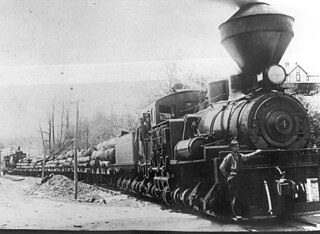
The White Top Railway was chartered as a common carrier in the early 20th century from a portion of the logging lines of the Hassinger Lumber Company in Washington and Grayson Counties, Virginia, United States. The move was born of the lumber company's need to protect its rail operations at points of intersection with the Virginia-Carolina Railway from possible condemnation for the V-C's own, expanding line.

The Oregon Railroad and Navigation Company (OR&N) was a railroad that operated a rail network of 1,143 miles (1,839 km) running east from Portland, Oregon, United States, to northeastern Oregon, northeastern Washington, and northern Idaho. It operated from 1896 as a consolidation of several smaller railroads.

Standard gauge was favored for railway construction in the United States, although a fairly large narrow-gauge system developed in the Rocky Mountains of Colorado and Utah. Isolated narrow-gauge lines were built in many areas to minimize construction costs for industrial transport or resort access, and some of these lines offered common carrier service. Outside Colorado, these isolated lines evolved into regional narrow-gauge systems in Maine, New York, Pennsylvania, Ohio, Iowa, Hawaii, and Alaska.

A forest railway, forest tram, timber line, logging railway or logging railroad is a mode of railway transport which is used for forestry tasks, primarily the transportation of felled logs to sawmills or railway stations.
The Caspar, South Fork & Eastern Railroad provided transportation for the Caspar Lumber Company in Mendocino County, California. The railroad operated the first steam locomotive on the coast of Mendocino County in 1875. Caspar Lumber Company lands became Jackson Demonstration State Forest in 1955, named for Caspar Lumber Company founder, Jacob Green Jackson.
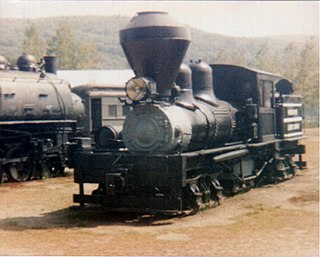
Meadow River Lumber Company No. 1 is a Shay locomotive at Steamtown National Historic Site, in Scranton, Pennsylvania. This 2-truck Shay was built by Lima Locomotive Works in May 1910. This type of locomotive was used primarily by lumber and mining companies. Some were used by other industries and on short lines. This is one of 77 Shay locomotives preserved in the United States.

George R. Vosburg was a steam tug that operated from 1900 to 1912 on the Columbia River and the north coast of Oregon south from Astoria to the Nehalem River and Tillamook City. Generally called the Vosburg in practice, and referred to as Geo. R. Vosburg in official records, this vessel performed many tasks, from carrying cargo and passengers, and towing barges of rock for jetty construction. After 1925, this vessel was renamed George M. Brown, and was converted to diesel power. Under the name George M. Brown, this vessel remained in service until 1968 or later.
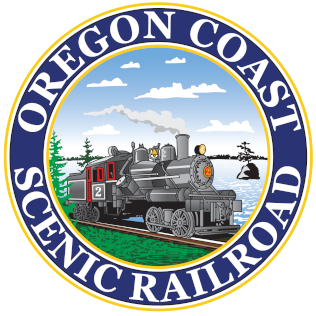
The Oregon Coast Scenic Railroad (OCSR) is a heritage railroad, a 501(c)(3) non-profit organization, operating in Oregon, primarily between Garibaldi and Rockaway Beach, with additional special trips to Wheeler, Nehalem River and into the Salmonberry River canyon. The railroad travels on tracks that pass along the edge of Tillamook Bay and the Oregon Coast, and through thick forest along the Nehalem River. The OCSR runs its collection of vintage rail equipment over 46 miles (74 km) of former Southern Pacific Transportation Company track under a lease from the Port of Tillamook Bay Railroad (POTB), an entity distinct from the OCSR.

The Mosquito and Coal Creek logging railroad was a 10 miles long private logging railway with a gauge of 3 foot (914 mm) near Eufaula, Washington.

Mount Emily Lumber Company No. 1 is a three-truck Shay steam locomotive that was originally owned by the Mount Emily Lumber Company. It was built in 1923 by the Lima Locomotive Works and delivered to Lima's Seattle dealer, Hofius Steel and Equipment Company of Seattle, Washington. It was later sold to the Independence Logging Company of Independence, Washington, and then it was later sold to the Mount Emily Lumber Company of La Grande, Oregon. When it was retired in 1955, it was donated to the Oregon Museum of Science and Industry. Three years later, in 1958, it was donated to the Oregon Historical Society of Portland, Oregon. The engine was operational at Cass Scenic Railroad and the City of Prineville Railroad for many years. It was announced in 2022 that the Oregon Rail Heritage Foundation would be the new owners of No. 1.






